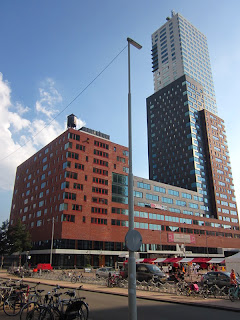This city 100 km southwest of Amsterdam was close enough to visit on a day trip by train. Together with Zwijndrecht, the city across the river, the population of the area is 190,000 people. It's location at the confluence of three major rivers made it a trading center that connected the finacial centers of Rotterdam and Den Hague to the north with delta cities of Breda and Antwerp to the south. Historic Dordrecht is a network of narrow roads bridging canals that meander between medieval buildings.
The town's 13th century der Grote Kerk or "the big church" is visible from the water at the western harbor to welcome sailors home (or to remind them that god was watching them). The play between old and new in this town is delicate but not reverent or conservative. At the center of old town is a town plaza surrounded by modern shopping.
The Dordrecht Museum by Dirk Jan Postel is a crafty juxtaposition of glass and metal amidst the brick and wood of the neighboring buildings.
I ventured outside the second canal to see the token Dutch windmill that dates back to 1713 and stands between a 1990's apartment building and a turn of the century (20th) row house building.
The 1939 Theater Cafe addition by Sybold to an 18th century neo-classical J. Verheul building shows that Dordrecht appreciates both new and old.
Today, planners have put in motion a scheme to develop the waterfront area west of the Hugo do Grootlaan bridge. This area is called Maasteras. It will comprise 80 acres on the north and south side of the Oude Maas river. It stands as a gateway to the two cities with proximity to historic Dordrecht and access from major roadways and the central train station.The north will be predominantly educational buildings for the Zwijndrecht and Dordrecht Colleges and office buildings. The south is planned as housing, offices and green space. Divided by an on ramp for the motor way, tunnel access for a second motor way and the base of the bridge itself, the southern site will pose some complex challenges for designers not least of which is the reroute of transport for hazardous cargo currently running through this zone.
Image from OMA
After 10 years in the drawer, the city of Rotterdam dusted off OMA's drawings for the 160,000 m2 De Rotterdam complex and started construction last year on Wilhelminapier. Now rising several floors out of the ground, the mass required to pull off the city within a building concept is obvious. Piano's design for the KPN Telecom building in 2000 was a creative counterbalance to Carlatrava's Erasmus bridge. The two structures stand adjacent to one another in mutual admiration of their structural prowess. The new complex tends to make the slender column supporting the canted facade of KPN look more like the legendary dutch boy Hans Brinker with his finger in the dyke.
Montevideo
Esplanade at New Orleans
The New Orleans tower opened recently and at 160.5m is just 4.5m shy of the Maas Tower down the street, now the tallest building in the Netherlands. Five more buildings named after American cities are designed, ready for construction when the economic tides start to shift once more.If you are in Rotterdam, visit the NAI (Netherlands Architecture Institute.) They have a top notch architecture book store, rotating and permanent art and architecture exhibits and self-guided tours of the Sonneveld house across the street. This is the best part as the Broek and Van der Vlught designed building is immaculately restored, including replicas of Van der Vlugts furniture designs.














No comments:
Post a Comment